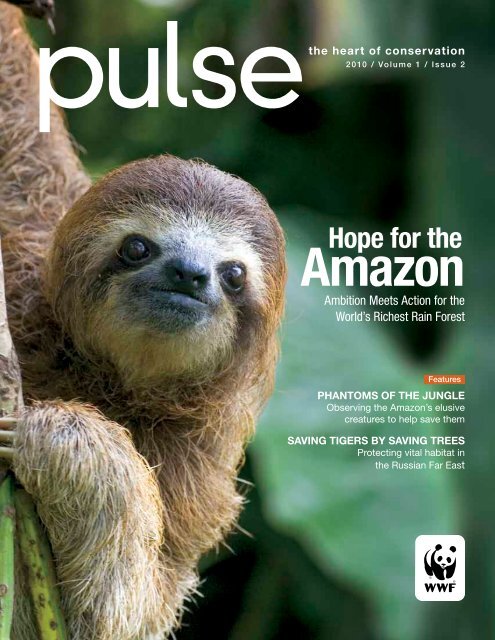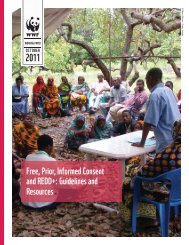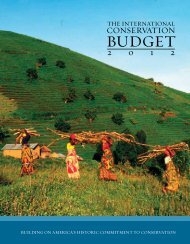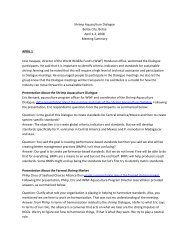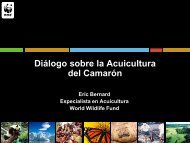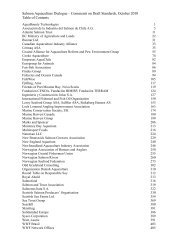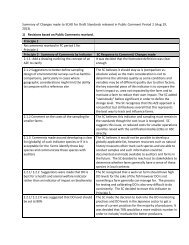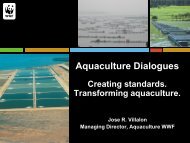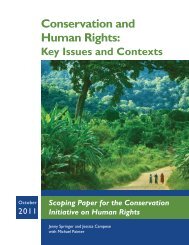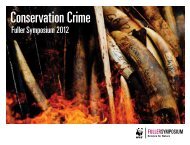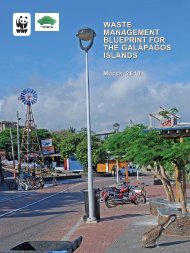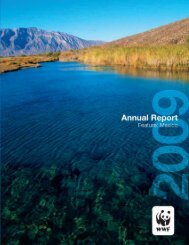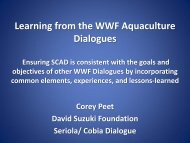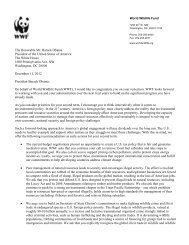Amazon - World Wildlife Fund
Amazon - World Wildlife Fund
Amazon - World Wildlife Fund
Create successful ePaper yourself
Turn your PDF publications into a flip-book with our unique Google optimized e-Paper software.
pulse<br />
the heart of conservation<br />
2 0 10 / Vo l u m e 1 / I s s u e 2<br />
Hope for the<br />
<strong>Amazon</strong><br />
Ambition Meets Action for the<br />
<strong>World</strong>’s Richest Rain Forest<br />
Features<br />
Phantoms of the Jungle<br />
Observing the <strong>Amazon</strong>’s elusive<br />
creatures to help save them<br />
Saving Tigers by Saving Trees<br />
Protecting vital habitat in<br />
the Russian Far East
the hear t of conser vation<br />
From the president<br />
Biodiversity in the Balance<br />
COVER<br />
3 Protect the <strong>Amazon</strong>, Protect the Earth<br />
The <strong>Amazon</strong> is a region of superlatives. Meg Symington,<br />
Jason Clay and Tom Lovejoy – three leading experts on<br />
the region – explain how WWF aims to keep it that way.<br />
FEAtuRES<br />
10 What the Monkeys Told Us<br />
In a report from the field, senior scientist George Powell tells how<br />
patience and technology converge to create protected areas for<br />
the denizens of the Peruvian <strong>Amazon</strong>.<br />
12 Global Action<br />
WWF helps fight ivory trafficking in Africa, thwart illegal fishing in<br />
the Galápagos, and encourage sustainable forestry in China.<br />
20 A Gift Born of Passion<br />
In the jungles of Ecuador, Sue Scott Stanley fell in love with the<br />
<strong>Amazon</strong>. Now she wants to help protect it.<br />
On tHE web<br />
Get to the heart of the story. Access enhanced content including<br />
video, podcasts, photo galleries and more at worldwildlife.org/pulse.<br />
Pulse: The Heart of Conservation<br />
is published twice a year by<br />
<strong>World</strong> <strong>Wildlife</strong> <strong>Fund</strong>. All reporting,<br />
writing, editing and design is done<br />
by our WWF in-house staff.<br />
We value your comments and suggestions.<br />
Please email pulse@wwfus.org or write the<br />
address below:<br />
Pulse<br />
Donor Engagement<br />
<strong>World</strong> <strong>Wildlife</strong> <strong>Fund</strong><br />
1250 24th Street, NW<br />
Washington, DC 20037-1193<br />
Cover image: A young brown-throated<br />
three-toed sloth hanging from a branch.<br />
© Roy TOFT<br />
FPO<br />
© BREnt StiRTOn / GETTy Images / WWF<br />
The first thing you notice<br />
about the <strong>Amazon</strong> is that<br />
it is mostly intact.<br />
© wwf-us<br />
Of the world’s three great forests, the <strong>Amazon</strong> is<br />
the largest and retains 80 percent of its original forest<br />
cover. Fly in from Manaus or Quito and soon you’ll be<br />
gazing over a mind-bending expanse of green – hundreds<br />
of millions of forest acres that seemingly go on forever.<br />
But as you look over this magnificent panorama, you also<br />
see signs of the world to come. Just east of Quito, on the<br />
slope of the Andes, the view includes the Pan American<br />
Highway and the disruption it brings – logging, development<br />
and more. The reality of this destruction is stark:<br />
CO 2 emissions resulting from deforestation place Brazil<br />
among the top five global emitters.<br />
WWF has worked in the <strong>Amazon</strong> for 40 years. In<br />
1968, we supported the creation of Manu National<br />
Park. Grants made to study life in the <strong>Amazon</strong> led to<br />
renowned conservation biologist Tom Lovejoy’s definitive<br />
work on the effects of forest fragmentation. And in<br />
2002 we helped launch the <strong>Amazon</strong> Region Protected<br />
Areas project, one of the most ambitious conservation<br />
efforts in the world, to ensure comprehensive protection<br />
of the Brazilian <strong>Amazon</strong>. More than 79 million acres of<br />
forest have been safeguarded to date, an area slightly<br />
larger than the state of New Mexico.<br />
But while establishing parks will go a long way in the<br />
race to save the <strong>Amazon</strong>, we know that parks alone will<br />
never be enough. The market forces altering this place –<br />
such as agriculture and infrastructure – must also be<br />
addressed, and WWF’s conservation ethos has evolved<br />
to acknowledge these modern-day realities.<br />
We employ cutting-edge science to better understand<br />
what jaguars, macaws and other creatures need to<br />
survive in a modern world. We seek the right finance<br />
mechanisms to sustain the parks. We are partnering<br />
with governments and multilaterals to design smarter<br />
infrastructure. And we engage some of the world’s<br />
biggest companies in reconsidering their commodity<br />
production practices – for example, helping develop<br />
global standards for sustainable beef production by<br />
collaborating with Cargill, McDonald’s and others.<br />
The <strong>Amazon</strong> is a place where success builds on success,<br />
and I am extraordinarily proud of our track<br />
record here. But much remains to be done, and nothing<br />
short of the future of perhaps the world’s greatest<br />
forest, to say nothing of the world’s climate system,<br />
hangs in the balance. Read on for an in-depth look at<br />
the <strong>Amazon</strong> and WWF’s on-the-ground approach to<br />
protecting its irreplaceable treasures and renewing the<br />
landscapes that sustain them.<br />
Carter S. Roberts<br />
President & CEO<br />
Pulse: The hEART of consERvATion 1
© MICHEL ROGGO / WWF-CANON<br />
An acre of <strong>Amazon</strong> forest is lost every minute.<br />
WWF is working with governments, industry<br />
and communities to change that.<br />
© NIGEL DICKINSON / WWF-CANON<br />
The <strong>Amazon</strong> has been a focus of WWF conservation efforts for more than four<br />
decades. As the source of almost one-fifth of all free-flowing freshwater on Earth<br />
and home to lush forests that help modulate carbon emissions for the rest of the<br />
planet, the <strong>Amazon</strong> plays a significant role in maintaining the integrity of the<br />
global environment. But today rapid deforestation threatens to upset the balance<br />
provided by this rich and still largely unexplored landscape spanning eight South<br />
American countries. On a 99 degree day during the warmest June on record, three<br />
experts sat down at our Washington, D.C. headquarters to discuss the threats to the<br />
<strong>Amazon</strong> and why it is so important for WWF – and others – to act now to preserve it. <br />
2 WORLDWILDLIFE.ORG/PULSE<br />
PULSE: THE HEART OF CONSERVATION<br />
3
All PhOTOs © wwf-us<br />
Jason Clay<br />
Vice President<br />
Market Transformation<br />
WWF<br />
Tom Lovejoy<br />
Professor, George Mason<br />
University; Biodiversity<br />
Chair, the Heinz Center;<br />
Member of the Board, WWF<br />
Meg Symington<br />
Managing Director<br />
<strong>Amazon</strong> Program<br />
WWF<br />
Poison dart frogs<br />
<strong>Amazon</strong> river dolphin<br />
© TODD PussER / npl / MinDEn PictuREs © MichAEl D. Kern<br />
Making conservation history<br />
by safeguarding the world’s<br />
richest ecosystem<br />
MEG SYMINGTON One of the things that’s most outstanding<br />
about the <strong>Amazon</strong>, in my mind, is its biodiversity.<br />
We say that 10 percent of all known species<br />
on Earth are found here, but really, it could be up<br />
to 33 percent if you include those species still being<br />
identified.<br />
TOM One of the other interesting aspects of biodiversity<br />
is how it contributes to the development of the<br />
life sciences and spills over and has health benefits.<br />
Literally, there are tens if not hundreds of millions of<br />
people who take ACE inhibitors for their high blood<br />
pressure, and that all goes back to how the venom<br />
of the bushmaster works. The bushmaster is a big,<br />
nasty snake that lives in the <strong>Amazon</strong>, and basically<br />
it makes its prey’s blood pressure go to zero. Forever.<br />
By studying the venom, researchers uncovered the<br />
system of regulation called the angiotensin system.<br />
That’s what the ACE inhibitors were designed to<br />
work on. Until somebody was looking at how the<br />
venom worked, nobody had a clue how to do this.<br />
The world’s largest<br />
tropical rain forest,<br />
the <strong>Amazon</strong> encompasses<br />
a staggering<br />
1.4 billion acres.<br />
TOM LOVEJOY People don’t realize how important<br />
MEG And the toxins in the poison dart frogs are also<br />
biodiversity is, in terms of how many fundamen-<br />
being used to develop heart stimulants.<br />
tal resources it provides, how it supports all living<br />
things – including people.<br />
JASON I don’t think what is economically valuable<br />
from the <strong>Amazon</strong> has even really been tapped yet.<br />
MEG True. We rely on biodiversity to help us discover<br />
new medicines and to learn how to grow food<br />
TOM When you get to the <strong>Amazon</strong>, you really un-<br />
Ringed kingfisher<br />
© R.IsOTTi, A.cAMBOne - Homo AMBiens / WWF-cAnon<br />
more productively. We’re not just preserving the<br />
<strong>Amazon</strong> for preservation’s sake.<br />
JASON CLAY For example, there is a palm tree there,<br />
called peach palm, that’s so productive it actually<br />
makes ten times more vegetable protein and calories<br />
per acre than the best corn in Iowa. So as we strive to<br />
feed 9 billion people on this planet, with most of them<br />
living in the tropics, we’re going to start looking to<br />
plants like the peach palm to solve the food shortage.<br />
derstand that this is a living planet. It’s a physical<br />
and biological system linked together, and forests<br />
as a whole play a huge role in all of that, especially<br />
when it comes to climate. It’s pretty simple to the extent<br />
that if you destroy the forest, the carbon that<br />
was stored in the trees goes up in the atmosphere and<br />
creates more climate change. And if you reforest, you<br />
can pull some of that carbon out of the atmosphere,<br />
you can start managing the planet in a much more<br />
sensible way than we’ve been doing.<br />
The <strong>Amazon</strong> River<br />
is so massive it<br />
actually contains<br />
more water than the<br />
Mississippi, the Nile<br />
and the Yangtze<br />
rivers combined.<br />
4 worlDWildliFE.ORG/pulse<br />
Pulse: The hEART of consERvATion<br />
5
MEG Deforestation or forest destruction is responsible for 15<br />
percent of the total greenhouse gas emissions on the planet. And<br />
the <strong>Amazon</strong>’s about half of that. That’s a significant percentage<br />
of total global emissions and if you were to vaporize the <strong>Amazon</strong><br />
tomorrow, the amount of carbon released into the atmosphere<br />
would be equivalent to 10 to 15 years of man-made emissions.<br />
TOM The <strong>Amazon</strong> also plays an important role in global hydrology.<br />
It actually makes half of its own rain, but the impact of<br />
that is quite far-reaching. As the moisture hits the high wall of<br />
the Andes, some of it deflects south and some of it north. This<br />
moisture goes south right into important agro-industrial areas in<br />
southern Mato Grosso, Sao Paulo, and even northern Argentina.<br />
JASON So when you deforest the <strong>Amazon</strong>, you’re disrupting<br />
this “bellows” that sends rain from the east to the west.<br />
Through a cycle of evaporation, it produces rainfall about six<br />
times by the time you get to the mountains. And what goes<br />
south about nine months later is a perfect indicator for how<br />
much rain there’s going to be for grain production in South<br />
Africa. And the part that goes north, there’s even speculation<br />
that this influences the Gulf Stream. The rain forest has an<br />
enormous impact on global climate.<br />
TOM In the reverse, climate change has an enormous impact on<br />
the rain forest as well. But this is a slightly complicated picture,<br />
and also a hugely important and scary one. With the normal climatic<br />
cycle, El Niño-La Niña, you alternate between wet and dry<br />
periods. With El Niño you get really dry at times in the <strong>Amazon</strong>.<br />
Superimposed on that is human-driven climate change. And the<br />
Hadley Centre, which is one of the five major computer centers<br />
doing climate modeling, showed that with just a slight rise in<br />
global temperature, you could actually get a reduction in rainfall<br />
in the south and the eastern <strong>Amazon</strong>, essentially to a point<br />
where it no longer can support rain forests and would gradually<br />
become savanna. That’s called <strong>Amazon</strong> dieback.<br />
They first projected this would occur at a 2-1/2 degrees increase<br />
in global temperature. Then last year they revised it to<br />
2 degrees. On top of that, the <strong>World</strong> Bank did a million-dollar<br />
study last year in which, for the first time, modeling combined<br />
climate, deforestation and fire, each of which has been known<br />
to have some kind of impact. And that study suggests that you<br />
could have a tipping point for dieback at 20 percent deforestation.<br />
It is currently at 18 percent.<br />
JASON Certainly deforestation is one of the major threats to<br />
the <strong>Amazon</strong>. About 75 to 80 percent of the <strong>Amazon</strong> that has<br />
been cut is related to cattle and beef production. Ranchers cut<br />
If recent trends do not change, the <strong>Amazon</strong> could see dramatic changes<br />
over the next two decades. These maps show scientists’ predictions of<br />
ongoing deforestation. The worst of it occurs along roads.<br />
trees because that is a way they can make a living, by turning<br />
forest into pasture. But what if trees had a value? What if carbon<br />
payments became significant enough that trees actually<br />
had more value as trees than as cleared pasture to grow beef?<br />
Right now, some ranchers in Brazil suggest that with carbon<br />
even at 50 cents to $1 a ton, they would make more money selling<br />
carbon than selling beef.<br />
That’s a whole new ball game. That’s a fundamentally different<br />
issue where ranchers could be convinced not to cut. Why would<br />
you cut trees if you were actually reducing your assets?<br />
MEG I want to point out that what’s underlying the agricultural<br />
expansion and that threat to the <strong>Amazon</strong> are the expanding<br />
global markets for soy and for beef as the middle<br />
class expands globally and we have more people who want<br />
to eat meat. Soy is used as a feed for livestock. And beef is a<br />
popular export. So rising affluence around the world is the<br />
root cause of the agricultural expansion.<br />
Maps by WWF-Peru based on Soares-Filho et al 2006<br />
Soybeans with rotary irrigation system<br />
Peach palm<br />
© EDWARD PARkER / WWF-cAnon<br />
© DiEGO M. GARces / WWF-cAnon<br />
Macaw<br />
Bushmaster snake<br />
© ChrisTOPhER MuRRAy © Anand ShARMA<br />
6 worlDWildliFE.ORG/pulse Pulse: The hEART of consERvATion 7
Protecting the <strong>Amazon</strong>’s Forests<br />
231,661 mi 2<br />
Through 2009, WWF has helped protect an area of forest in<br />
the Brazilian <strong>Amazon</strong> approximately the size of New Mexico<br />
through the <strong>Amazon</strong> Region Protected Areas program (ARPA).<br />
By the end of Phase 3, the program will encompass an area<br />
almost 50 percent larger than the state of California.<br />
125,483 mi 2 175,676 mi 2<br />
So if Nike says they don’t want to buy leather that’s come from<br />
deforested parts of the <strong>Amazon</strong>, you listen because that is<br />
half of your profit. When General Mills and Dannon, both of<br />
which use gelatin made from cattle by-products in their yogurts,<br />
say they won’t buy from deforested areas, you listen.<br />
MEG Protected areas are another tool that we have. A recent<br />
paper attributed 37 percent of the total decrease in deforestation<br />
over the last five years to the expansion of the protected<br />
area system, and about 44 percent to the decrease in demand<br />
for agricultural products due to the economic downturn. So<br />
protected areas and agricultural demand are about equally<br />
important in terms of mediating deforestation pressures.<br />
Phase 1 Phase 2 Phase 3<br />
2002 2009 2013 Goal<br />
JASON Did you know that the <strong>Amazon</strong>’s largest trading<br />
partner right now is not the U.S.? Its biggest trading partner<br />
is China. That’s because while the U.S. and European econ-<br />
TOM There’s been a spectacular gain in protected area coverage<br />
in the <strong>Amazon</strong> in the last 15 years.<br />
omies are still reeling, in 2009 China imported 30 percent<br />
more soy than in 2008, and this year 10 percent more again.<br />
The Asian economies are bouncing back faster.<br />
MEG Yes — in 1999, the WWF forest campaign came up with<br />
the idea of challenging all of the governments of all of the<br />
countries around the world to protect 10 percent of their forests.<br />
And Brazil’s President Cardoso stepped up to the challenge<br />
and made that commitment to protect 10 percent of the<br />
<strong>Amazon</strong>. That has resulted in huge gains in new protected<br />
areas. WWF has catalyzed that initial commitment and since<br />
then we’ve worked really closely with the government of Brazil<br />
and the other donor partners to implement that program.<br />
Children on the way to school in the morning in the Brazilian <strong>Amazon</strong>. There are more than 30 million people living in the <strong>Amazon</strong>, including more than 220<br />
indigenous groups. By promoting the local management of indigenous territories, WWF supports indigenous peoples’ rights and traditional lifestyles and<br />
ensures the long-term conservation of important ecosystems.<br />
© BRAsil2<br />
TOM We also have to be concerned about infrastructure, which<br />
is what makes all of this trade possible. It’s all about access.<br />
Those nuances, coupled with science that says where you need<br />
parks from a diversity point of view and from a connectivity<br />
point of view, have made it a lot easier politically to get these<br />
new areas accepted than simply saying we want to put a fence<br />
around the <strong>Amazon</strong>. Science has played a role. As we’ve understood<br />
better what needs to be protected, we have been able<br />
to make a better case for why it should be protected. There’s<br />
a good moral there.<br />
MEG WWF is just developing its strategy in terms of what<br />
we want to focus on with redd in the <strong>Amazon</strong>. But one really<br />
strong emphasis of our work is building the capacity of governments<br />
to do what they need to do in terms of monitoring<br />
deforestation, setting a national baseline, and being able to<br />
report on that.<br />
MEG The roads allow access to the frontier and allow you<br />
to get the crops out to market. Most deforestation of the<br />
<strong>Amazon</strong> occurs within less than four miles of a road.<br />
The western <strong>Amazon</strong> has been protected for many, many<br />
years by being so remote and having no road access. But<br />
now they’re going to open up large parts of the western<br />
<strong>Amazon</strong>. For the first time now we’re getting roads that are<br />
going to reach all the way from the Atlantic to the Pacific.<br />
We need to work with zoning, make the standing forest<br />
valuable so that there will be incentives not to clear it alongside<br />
the road.<br />
The total goal is to protect about 232,000 square miles of the<br />
Brazilian <strong>Amazon</strong>, which is an area larger than the total U.S.<br />
National Park system. And we’re at about 125,000 square<br />
miles now. It’s predicted that those goals will be achieved over<br />
the next eight years.<br />
We’re also doing a lot in terms of capacity building with<br />
indigenous peoples, trying to increase their ability to engage<br />
in the international negotiations on redd. And we’re trying<br />
to inform and educate ourselves by doing some pilot<br />
projects on the ground, where we try to actually find an area<br />
that’s under threat of deforestation, protect it, quantify the<br />
carbon saved, and then market and sell those carbon credits.<br />
MEG Another way we can make a significant impact is with<br />
redd (Reducing Emissions from Deforestation and Forest<br />
Degradation). This is a component of the negotiations to be<br />
included in the next phase of the global climate treaty. redd<br />
is basically the idea that governments would be compensated<br />
for decreasing their emissions from deforestation and forest<br />
degradation. It’s a very, very complex topic but one that has<br />
great promise for the <strong>Amazon</strong>.<br />
You also have more than 20 percent of the <strong>Amazon</strong> demarcated<br />
as indigenous land. And obviously indigenous peoples are<br />
very dependent on those lands and forests to maintain their<br />
traditional lifestyle. They are, in many cases, the most effective<br />
stewards of forest conservation.<br />
JASON Last summer we were approached by Nike, General<br />
Mills and Dannon about the issue of deforestation and the<br />
beef industry. Now you wouldn’t think of these three companies<br />
as being very connected to beef, but in point of fact<br />
the beef industry in any part of the world only breaks even<br />
selling meat. They make their money selling what we think<br />
of as cattle by-products, most importantly hides and hooves.<br />
TOM We’ve got so much going on in the way of emissions.<br />
And yes, it can get complicated. But you don’t have to have<br />
a perfect system in order to make it work. Most things in human<br />
affairs are operated with error bars anyway.<br />
TOM It’s an idea that’s been around for a long time. It springs<br />
directly from what we were talking about earlier, about the<br />
amount of carbon and the degradation of ecosystems adding<br />
to the atmosphere.<br />
JASON The reason so much land has been set aside in Brazil<br />
is in part because there are different types of demarcation. In<br />
some types, resource use is allowed; in others it isn’t.<br />
redd is essential for going forward. We’ve just got to do it.<br />
8 worlDWildliFE.ORG/pulse Pulse: The hEART of consERvATion 9
From the Field<br />
phOTO couRTEsy of GEORGE POWEll<br />
George Powell (center) with his field assistants,<br />
Jimmy Gustavo (left) and Rene Escudero (right).<br />
It took months, but eventually we<br />
learned a few things about the sakis that<br />
helped us to understand their habitat<br />
needs. We found, for example, that unlike<br />
other monkeys, this rare species does not<br />
phOTO couRTEsy of GEORGE POWEll<br />
Like the big cats, peccaries – pig-like<br />
animals that live in groups of up to<br />
1,000 and are a key source of food<br />
for the Amur Indians – also prefer to<br />
feed in the flood plains of larger rivers.<br />
There they find the palm nuts they<br />
depend on for sustenance. Because the<br />
palm trees are widely scattered except<br />
in floodplains, the peccaries must<br />
travel from river to river, often covering<br />
30 to 40 miles in search of a new<br />
feeding area.<br />
Macaws, we learned, also travel great<br />
distances − up to 100 miles − when not<br />
nesting. The team captured and tagged<br />
these amazing birds by erecting scaf-<br />
and protected areas are considerably<br />
smaller than this total. We will need<br />
to ensure that there is sufficient connectivity<br />
between parks and reserves<br />
to allow these species to maintain large<br />
enough populations.<br />
I came to recognize the importance of<br />
this kind of information decades ago,<br />
when I was doing my graduate work in<br />
Costa Rica studying the habitat of the<br />
quetzal, a strikingly colored tropical<br />
bird. Sadly, in those days national park<br />
boundaries were determined based on<br />
politics, rather than on conservation<br />
theory, and they were far less effective<br />
in protecting the native species for<br />
which they were established.<br />
Bald-faced saki<br />
Monkeys<br />
What the By Dr. George Powell<br />
Told Us<br />
The science of conservation planning<br />
requires identifying which kinds of<br />
habitat are necessary and how to integrate<br />
them into large enough areas<br />
to protect the maximum number of<br />
species. Since we clearly can’t study all<br />
of the myriad species that live in any<br />
one section of the <strong>Amazon</strong>, we selected<br />
eat ripened fruit, but prefers the seeds<br />
of immature fruit. We also learned that,<br />
unlike other monkeys, the saki does not<br />
come crashing through the trees but<br />
quietly slips from branch to branch,<br />
travelling in small families of five or<br />
six, rather than in larger groups. That<br />
means they need to live in dense, mature<br />
forested areas where the branches are<br />
close enough together for them to travel<br />
without making much noise.<br />
folding up to 100 feet high in order to<br />
reach their nests.<br />
We’ll now compile all of these data into<br />
an assessment to determine how much<br />
area we believe needs to be protected,<br />
and how much of each particular habitat.<br />
Clearly, the area will be large −<br />
likely millions of acres. An immediate<br />
concern arises from this conclusion<br />
because most individual national parks<br />
Though we had to stop our work earlier<br />
than we wanted for lack of funding,<br />
I am confident that the information<br />
we’ve gleaned from tracking these<br />
disparate species will enable decision<br />
makers to better protect the abundance<br />
of wildlife that calls the Peruvian<br />
<strong>Amazon</strong> home.<br />
Dr. George Powell is a senior<br />
conservation scientist with WWF.<br />
those suspected of being the most area-<br />
Tracking the other species, though rel-<br />
sensitive, with the assumption that pro-<br />
atively simpler, likewise taught us some<br />
tecting critical habitat for these species<br />
things that surprised us. For example,<br />
During my six years in the Madre de Dios region of the Peruvian<br />
<strong>Amazon</strong>, I learned to listen for the soft twitter that meant a family<br />
of bald-faced sakis was nearby. With my team of graduate students,<br />
local woodsmen, and former-hunters-turned-conservationists,<br />
I spent thousands of hours watching and waiting for the surprisingly<br />
hairy little monkeys to appear, only to have them vanish after<br />
a fleeting glimpse.<br />
would likewise protect areas critical to<br />
hundreds more.<br />
Unlike the other species we selected,<br />
however, the sakis, which we came<br />
to regard as the “phantoms of the<br />
jungle,” could not be captured and fitted<br />
with Gps-adapted collars to help<br />
us track their movements. To learn<br />
by capturing and collaring jaguars<br />
and pumas, we learned that these big<br />
cats behave quite differently from each<br />
other. Big cats are believed to be territorial,<br />
with individual males claiming<br />
an area exclusively. This we found to<br />
be true of the pumas we tracked, but<br />
the male jaguars overlapped territories<br />
quite comfortably.<br />
about this species, so rarely observed<br />
But watch and wait we did, because we<br />
the information we needed to determine<br />
by humans because of their talent for<br />
We were likewise surprised to see that<br />
knew that learning about the eating<br />
how much and what type of land should<br />
instantaneously disappearing into<br />
both jaguars and pumas, previously<br />
habits and distribution patterns of this<br />
be protected in this slice of the <strong>Amazon</strong>.<br />
the landscape, we had to help them<br />
assumed to live scattered throughout<br />
“umbrella species” − along with those<br />
Geneticists tell us that at least 2,000 in-<br />
habituate to us. That is, we needed to<br />
the jungle, preferred to forage along<br />
of several other far-ranging species<br />
such as jaguars, pumas, macaws and<br />
white-lipped peccaries − would give us<br />
dividuals must live in a species’ population<br />
in order for that species to be safely<br />
conserved in perpetuity.<br />
teach them not to be afraid of us, by<br />
quietly observing them for as long as<br />
they would allow it.<br />
the riverbeds. These findings indicate<br />
that protecting this species will require<br />
securing large expanses of river area.<br />
Data collected from GPS-based TrackTags worn by a male and female jaguar demonstrate the cats’<br />
affinity for riparian habitat. Human development tends to have a heavy impact on <strong>Amazon</strong>ian rivers,<br />
which are poorly represented in protected areas.<br />
10 worlDWildliFE.ORG/pulse Pulse: The hEART of consERvATion 11
Global Action<br />
From the <strong>Amazon</strong> to the Arctic, WWF is building a future<br />
where human needs are met in harmony with nature.<br />
Blue whales are among the many<br />
species found along the coasts<br />
of Southern Chile, where WWF is<br />
helping to identify marine areas for<br />
future protection.<br />
We are strategically focusing on<br />
conserving critical places and species<br />
while also working to reduce humanity’s<br />
ecological footprint. Here are some<br />
highlights of WWF’s recent successes<br />
made possible by your support.<br />
SPECIES<br />
FIGHTING THE ILLEGAL<br />
ivory TRADE IN AFRICA<br />
In China, an expanding<br />
middle class has an appetite<br />
for luxury items –<br />
including those made of<br />
ivory. In Central Africa, a<br />
decrease in timber company<br />
jobs has left people unemployed.<br />
In combination,<br />
these forces have pushed<br />
ivory prices higher and<br />
made poaching a tempting<br />
source of income for those<br />
without work. The result?<br />
Illegal ivory trading is on<br />
the rise.<br />
In this situation, the<br />
efforts of trAFFIC,<br />
WWF’s wildlife trade<br />
monitoring network, come<br />
to the fore. Our ongoing<br />
work to build the capacity<br />
of local governments<br />
to enforce wildlife trade<br />
laws has helped lead to<br />
the first-ever poaching arrests<br />
in Africa. One case<br />
yielded 157 ivory objects<br />
that weighed more than<br />
440 pounds.<br />
Since its inception in 1976,<br />
trAFFIC has developed<br />
extensive intelligence<br />
networks in Southeast<br />
Asia, focusing on cities<br />
that are major hubs for<br />
illegal trade. We are now<br />
working to replicate this<br />
success in Africa, in countries<br />
such as the Congo,<br />
the Democratic Republic<br />
of Congo, Cameroon,<br />
Central African Republic<br />
and Gabon. Elephant populations<br />
are most at risk<br />
in these countries, where<br />
inadequate legislation<br />
and poor law enforcement<br />
have allowed ivory sellers<br />
to thrive.<br />
MAPPing Priority<br />
regions IN SOUTHERN<br />
Chile<br />
Southern Chile is home<br />
to a number of distinctive<br />
species, including blue<br />
whales – the largest animals<br />
on Earth – humpback whales,<br />
sea lions, deep sea corals,<br />
penguins, dolphins, albatrosses<br />
and petrels. But the<br />
region faces numerous<br />
threats. Salmon aquaculture,<br />
unsustainable logging, forest<br />
conversion, infrastructure<br />
projects and a lack of<br />
government enforcement all<br />
place these species at risk.<br />
Using innovative new software<br />
to map where species<br />
are most abundant and<br />
which areas have the highest<br />
potential for ecotourism,<br />
WWF has designated the<br />
Chiloense Ecoregion as a<br />
global priority for conservation,<br />
identifying 40 separate<br />
marine and coastal areas of<br />
high ecological and sociocultural<br />
importance. The<br />
126,000 square-mile area,<br />
recognized for its pristine<br />
environment and complex<br />
bio-oceanographic processes,<br />
covers six marine<br />
ecosystems.<br />
SAVING RUSSIAN TIGERS<br />
BY PROTECTING TREES<br />
Despite a global economic<br />
downturn that has reduced<br />
trade in most timber species,<br />
commercial trade in<br />
Korean pine, a key species<br />
found in Amur tiger habitat,<br />
has increased over the<br />
past decade. The rising demand<br />
has led to a massive<br />
increase in logging, much<br />
of it being carried out illegally<br />
in Russia’s remaining<br />
temperate forests.<br />
Around 400 Amur tigers<br />
survive in the native<br />
Korean pine forests of<br />
the Russian Far East and<br />
northeast China, where the<br />
pine nuts are an essential<br />
food source for tiger prey<br />
species. To help regulate<br />
the logging and protect<br />
tiger habitat, Russia<br />
has listed the Korean<br />
pine in Appendix III of<br />
Cites (the Convention<br />
on International Trade in<br />
Endangered Species). The<br />
listing means exports of<br />
Korean pine timber from<br />
Russia will need Cites<br />
permits, which will make<br />
it harder for the illegal<br />
timber trade to continue.<br />
© WWF Chile / ThOMAs CROWLEY<br />
12 worlDWildliFE.ORG/pulse Pulse: The hEART of consERvATion 13
© Nils WARnock, UC Davis, MAP couRTEsy GNPS<br />
© Michel GunthER / WWF-cAnon, © PABlo JAMioy<br />
WWF Program Officer Dennis Jørgensen releases a long-billed curlew<br />
during a tagging expedition.<br />
These maps from the VMS system are used by the Galápagos National Park<br />
Service to continuously monitor and control the activities of fishing vessels<br />
above 20 metric tons operating inside the Galápagos Marine Reserve.<br />
The ecotourism opportunities generated by gorilla habituation programs<br />
create economic incentives for the local community to protect these<br />
charismatic primates.<br />
EFN Fellow Pablo Jamioy (in hat) with a group of indigenous park guards on<br />
patrol in the Kamentsa Indigenous Reserve, Sibundoy, Putumayo, Colombia.<br />
In addition, the Ministry<br />
of Agriculture is expected<br />
to enact a ministerial order<br />
restricting the harvesting of<br />
Korean pine.<br />
Both of these actions follow<br />
lobbying from WWF and,<br />
more immediately, the recent<br />
airing of an undercover exposé<br />
that ran on Russia’s “presidential”<br />
television channel.<br />
Using information provided<br />
by WWF, the show exposed<br />
illegal logging in Primorsky<br />
Province and indicted a corrupt<br />
government official.<br />
TRACKING CURLEWS<br />
ACROSS NORTH AMERICA<br />
WWF is in its second<br />
year of tracking long-billed<br />
curlews, the largest shorebird<br />
in North America. An<br />
imperiled species, curlews<br />
come to the Northern Great<br />
Plains each spring to breed<br />
in the grasslands, where<br />
they find good nesting habitat<br />
and plentiful insects to<br />
feed upon. In the summer<br />
and fall they migrate to the<br />
southern United States and<br />
Mexico. But habitat degradation<br />
and cultivation<br />
are altering their wintering<br />
grounds and their migration<br />
stopover habitat with<br />
unknown consequences.<br />
In the spring of 2009 in the<br />
grasslands of Montana,<br />
WWF and partners fitted<br />
seven long-billed curlews<br />
with lightweight solar-powered<br />
satellite transmitters.<br />
Scientists then watched in<br />
near real-time as the birds<br />
migrated up to 1,800 miles<br />
south. In collaboration<br />
with WWF’s Chihuahuan<br />
Desert Program and the<br />
Universidad Autonoma<br />
de Nuevo Leon, WWF<br />
deployed three additional<br />
satellite tags on curlews in<br />
the grasslands of Mexico<br />
in October 2009. This<br />
spring, WWF tagged eight<br />
more birds in Montana.<br />
This research is providing<br />
critical data for developing<br />
effective conservation<br />
strategies for the birds’<br />
habitat. The curlews’ great<br />
migration also highlights the<br />
interconnectivity of North<br />
American grasslands and the<br />
importance of our local work<br />
and its global ties.<br />
THWarting ILLEGAL<br />
FISHING IN THE<br />
GALÁPAGOS<br />
The nearly 53,000<br />
square-mile Galápagos<br />
Marine Reserve is one of<br />
the largest marine reserves<br />
in the world, home to<br />
whales, whale sharks, rays,<br />
swordfish, sea turtles and<br />
other species of commercial<br />
and ecological interest. But<br />
though it has long enjoyed<br />
legal protection from commercial<br />
fishing, the reserve<br />
still feels the impact of<br />
illegal fishing activity by<br />
industrial fishing fleets and<br />
traditional boats. Last year,<br />
WWF took significant steps<br />
to help fight this infringement<br />
on protected waters.<br />
It had been difficult for the<br />
reserve’s limited number of<br />
law enforcement patrols to<br />
cover such a vast area. So,<br />
to thwart damaging fishing<br />
activities, WWF helped to<br />
deploy a Satellite Vessel<br />
Monitoring System (Vms)<br />
that provides real-time data<br />
on the position, route and<br />
speed of every ship above<br />
20 metric tons operating<br />
inside the reserve. The data<br />
enables patrol boats to efficiently<br />
target trespassers.<br />
More recently, we recruited<br />
vessel monitoring experts<br />
from Alaska to design a<br />
similar system for monitoring<br />
smaller boats, so<br />
that 100 percent of ships<br />
can be tracked. In addition,<br />
WWF is funding the<br />
design and implementation<br />
of an on-board Automatic<br />
Identification System that<br />
can automatically transmit<br />
several reports per minute<br />
showing the route, speed,<br />
navigation status and identification<br />
of every ship in<br />
the reserve.<br />
With the implementation<br />
of both systems, WWF expects<br />
the Galápagos Marine<br />
Reserve will become one<br />
of the better-controlled<br />
marine protected areas in<br />
the world.<br />
DEVELOPING GORILLA<br />
ECOTOURISM IN THE<br />
CENTRAL AFRICAN<br />
REPUBLIC<br />
Ever want to get up<br />
close and personal with a<br />
gorilla? WWF has found<br />
a way to allow people to<br />
do this, while at the same<br />
time benefitting local communities<br />
and raising funds<br />
for conservation.<br />
Since 1997, WWF has supported<br />
the Dzanga-Sangha<br />
Primate Habituation<br />
Program in its efforts<br />
to develop ecotourism<br />
through gorilla viewing.<br />
Local trackers have<br />
been employed to help<br />
habituate western lowland<br />
gorillas to the presence of<br />
humans. After some initial<br />
challenges, the first family<br />
of gorillas was successfully<br />
habituated and ecotourism<br />
opened in 2001.<br />
Today, hundreds of visitors<br />
each year observe the<br />
12 gorillas in the Group<br />
Makumba, named for its<br />
male silverback leader.<br />
Another group has been<br />
habituated since, and<br />
two more are in the process,<br />
creating financial<br />
opportunities for the<br />
local community and incentives<br />
to protect these<br />
magnificent creatures.<br />
CLIMATE<br />
GUIDING LAND-USE<br />
PLANNING IN SUMATRA<br />
Deforestation is causing<br />
biodiversity loss and<br />
degrading many ecosystem<br />
services in Sumatra.<br />
These services – the<br />
benefits nature provides<br />
us – include clean water,<br />
flood control, climate<br />
regulation, crop pollination,<br />
food, medicine,<br />
recreation and spiritual<br />
fulfillment. They are difficult<br />
to quantify, and<br />
are therefore typically ignored<br />
in decisions about<br />
land use – until now.<br />
A tool developed by the<br />
Natural Capital Project –<br />
a joint venture of WWF,<br />
Stanford University and The<br />
Nature Conservancy – is<br />
now being used by WWF<br />
and other nongovernmental<br />
organizations in Sumatra<br />
to map and value ecosystem<br />
services. InVest<br />
(Integrated Valuation of<br />
Ecosystem Services and<br />
Trade-offs) provides mapped<br />
information about where on<br />
the landscape ecosystem services<br />
are supplied, and how<br />
these patterns might change<br />
under future land-use scenarios.<br />
It can be overlaid<br />
with biodiversity information<br />
to see where ecosystem<br />
services and conservation<br />
priorities overlap.<br />
Working with a group<br />
known as Forum Tata<br />
Ruang Sumatera, WWF is<br />
using this information to<br />
make recommendations to<br />
local governments as they<br />
complete mandated landuse<br />
plans. For example,<br />
InVest results will indicate<br />
promising areas in which<br />
to encourage sustainable<br />
land use and conservation<br />
by establishing profitable<br />
incentives such as ecotourism,<br />
payments for watershed<br />
services, forest carbon projects,<br />
and certified forestry<br />
and agriculture.<br />
BUILDING INDIGENOUS<br />
CAPACITY IN THE AMAZON<br />
WWF’s Russell E. Train<br />
Education for Nature<br />
Program strives to build a<br />
dynamic and highly qualified<br />
corps of conservation leaders<br />
in Africa, Asia and Latin<br />
America by awarding education<br />
fellowships to people<br />
who can use their training to<br />
bring increased sustainability<br />
to their home communities.<br />
Pablo Herman Jamioy<br />
Juajibioy, who received a<br />
fellowship in 2006, has leveraged<br />
his education to win<br />
additional WWF and <strong>World</strong><br />
Bank grants that allow him<br />
to wed traditional terminology<br />
and ideas from his<br />
Kamentsa Indian culture<br />
14 worlDWildliFE.ORG/pulse Pulse: The hEART of consERvATion 15
WWF is working to protect the Chukchi<br />
Sea region in northern Alaska, home<br />
to magnificent creatures such as the<br />
walrus. In August there was evidence<br />
that they were being forced ashore as<br />
sea-ice disappeared from the Chukchi,<br />
with an unprecedented 10,000 to 20,000<br />
walruses onshore by mid-September.<br />
© TOMia Island FishER Cooperative MEMBERs, © Wim van Passel / WWF-cAnon<br />
KOMUNTO fishermen – pictured here with Veda Santiadji (far left) and<br />
Taswin Munier (far right), both from WWF-Indonesia, and Catherine Plume<br />
(fifth from left, back row) from WWF-US.<br />
The incredible success of communal conservancies in Namibia has helped<br />
increase the populations of predators such as lions while generating<br />
income and improving human welfare.<br />
© John PitchER<br />
with modern technology<br />
like Gis to improve indigenous<br />
land planning.<br />
For Pablo and his community<br />
in Colombia, improved<br />
land management<br />
will help as they adapt<br />
to a changing climate.<br />
It will position them to<br />
receive funding through<br />
sources supporting REDD<br />
(Reducing Emissions from<br />
Deforestation and Forest<br />
Degradation) activities.<br />
Forest monitoring is at the<br />
foundation of REDD, and<br />
Pablo is providing his community<br />
with the tools they<br />
need to sustainably manage<br />
and expand their forests.<br />
USING the Courts to<br />
ProteCT the arCtiC<br />
WWF’s long campaign<br />
to protect Alaska’s Arctic<br />
seas and coastlines from oil<br />
and gas development won<br />
a major victory when a federal<br />
court put a hold on recent<br />
leases that would have<br />
opened up the Chukchi Sea<br />
to new drilling.<br />
In siding with the plaintiffs<br />
challenging Lease<br />
Sale 193 – a group consisting<br />
of native Alaskan<br />
and conservation<br />
organizations, including<br />
WWF – the Federal<br />
District Court of Alaska<br />
ruled that the Minerals<br />
Management Service<br />
failed to conduct proper<br />
environmental reviews.<br />
The court directed the<br />
agency to consider impacts<br />
of gas development<br />
and to address the question<br />
of whether missing<br />
information about<br />
the environment in the<br />
Chukchi is essential for<br />
proper decision making<br />
and how that information<br />
might be gathered.<br />
The Chukchi is home<br />
to one of America’s two<br />
polar bear populations;<br />
beluga, bowhead and<br />
gray whales; millions of<br />
birds; and a remarkably<br />
rich marine ecosystem<br />
that supports many indigenous<br />
communities.<br />
PEOPLE<br />
SUPPORTING LOCAL<br />
FISHERMEN IN THE<br />
CORAL TRIANGLE<br />
An Indonesian fishermen’s<br />
group that partners<br />
with WWF to preserve<br />
marine resources has been<br />
awarded a 2010 United<br />
Nations Equator Prize in<br />
recognition of its outstanding<br />
efforts to reduce<br />
poverty through the<br />
conservation of biodiversity.<br />
The prize recognizes<br />
KomUnto, a community-based<br />
organization<br />
composed of representatives<br />
from fishing groups<br />
from the small island of<br />
Tomia, located in Wakatobi<br />
National Marine Park.<br />
Formed in response to a<br />
vacuum in natural resource<br />
management by local government<br />
and the encroachment<br />
of commercial fishing<br />
interests, KomUnto has<br />
mobilized isolated groups<br />
of fishermen into a powerful<br />
movement for positive environmental<br />
and social change.<br />
To help raise the visibility<br />
of its often-marginalized<br />
members, KomUnto<br />
has forged partnerships<br />
with other organizations<br />
that share its goals. One<br />
such partnership is the<br />
tnC-WWF Wakatobi Joint<br />
Program, which assists the<br />
group with technical expertise<br />
on fisheries management.<br />
Through these partnerships,<br />
WWF has helped<br />
train local conservation<br />
agents who now contribute<br />
to decision-making activities<br />
in their home villages.<br />
CREATING A FRAMEWORK<br />
FOR SUCCESS IN NAMIBIA<br />
Over the past two decades,<br />
WWF has helped<br />
Namibia form a communal<br />
conservancy framework that<br />
promotes sustainable natural<br />
resource management by<br />
allowing communities to<br />
control local wildlife management<br />
and tourism.<br />
Because it directly benefits<br />
them, these communities<br />
have come to see wildlife<br />
16 worlDWildliFE.ORG/pulse Pulse: The hEART of consERvATion 17
phOTO couRTEsy of David Cheng, © FREDERick J. WeyERhAEusER / WWF-cAnon<br />
© ROGER Leguen / WWF-cAnon, © FREDERick J. WeyERhAEusER / WWF-cAnon<br />
The permanent metal roofs WWF provided for homes like this in the<br />
Trongsa district help improve villagers’ living conditions, reduce labor<br />
needs and protect the forests.<br />
Working with WWF, David Cheng – Walmart’s global sourcing director –<br />
explains the company’s timber sourcing policy and requirements to suppliers.<br />
Saurus crane numbers have stabilized in Vietnam’s Tram Chim National<br />
Park thanks to a partnership between WWF and The Coca-Cola Company.<br />
Local residents, such as this fisherman from Bazaruto Island in Mozambique,<br />
benefit from WWF’s work to secure sustainable funding for conservation.<br />
as a valued livelihood asset<br />
and are now promoting<br />
wildlife management on<br />
vast tracts of land where<br />
poaching is no longer acceptable.<br />
Since its inception,<br />
the program has<br />
grown to include more<br />
than 235,000 community<br />
members in 59 registered<br />
communal conservancies<br />
across Namibia, covering<br />
more than 32 million acres<br />
of prime wildlife habitat.<br />
It has shown remarkable<br />
success in increasing the<br />
populations of such rare<br />
species as the black rhino<br />
and top-of-the-food-chain<br />
predators such as the desert<br />
lion. Human welfare is also<br />
improving, thanks to the<br />
more than $5.7 million in<br />
annual income and benefits<br />
the conservancies generate<br />
for the communities.<br />
As a result of this huge success,<br />
Namibia’s Communal<br />
Conservancy Tourism Sector<br />
was recently nominated as<br />
one of three finalists in the<br />
<strong>World</strong> Travel & Tourism<br />
Council’s “Tourism for<br />
Tomorrow Awards.”<br />
PRESERVING TREES BY<br />
USING ALTERNATIVE<br />
ROOFING MATERIALS IN<br />
bhutan<br />
A significant demand<br />
on forest resources in<br />
Bhutan comes from the<br />
need for roofing materials,<br />
traditionally made of<br />
fir tree shingles or bamboo<br />
thatching. Harvesting<br />
these materials places a<br />
real strain on natural resources,<br />
endangers habitat<br />
critical to the red panda,<br />
and requires enormous<br />
amounts of villagers’ time.<br />
Thanks to private contributions,<br />
WWF has been<br />
able to provide corrugated,<br />
galvanized iron roofing<br />
sheets as an alternative<br />
roofing material. These<br />
sheets, which last for 30<br />
years, reduce the strain<br />
both on natural resources<br />
and villagers’ labor.<br />
Through this initiative so<br />
far we have provided iron<br />
roofing sheets to more than<br />
500 households in different<br />
parts of the country, eliminating<br />
the need to cut down<br />
approximately 700 trees<br />
every year. Within the 30-<br />
year lifespan of the roofing<br />
sheets, about 21,000 trees<br />
will be saved.<br />
MARKETS<br />
SHIFTING CHINESE<br />
forestry TOWARD<br />
sustainability<br />
China’s growing economy<br />
continues to place more<br />
pressure on the planet’s<br />
resources. Through the<br />
WWF-led Global Forest &<br />
Trade Network (GFtn),<br />
WWF is working in China<br />
to influence economic<br />
development that goes<br />
hand-in-hand with longterm<br />
sustainability and<br />
environmental protection.<br />
In particular, GFtn is<br />
working with committed<br />
companies like Walmart,<br />
the world’s largest retailer,<br />
to harness the power of<br />
China’s international trade<br />
flow in ways that reduce<br />
China’s ecological footprint<br />
on forests.<br />
Walmart and GFtn recently<br />
cohosted a training workshop<br />
on responsible timber<br />
sourcing for the company’s<br />
wood suppliers in Shenzhen,<br />
China. Attendees included<br />
Walmart’s top suppliers of<br />
wood products to the U.S.<br />
market. At the workshop,<br />
GFtn showed these suppliers<br />
how to mitigate the<br />
risk of sourcing and trading<br />
illegally harvested wood by<br />
establishing a responsible<br />
purchasing program and<br />
committing to sourcing<br />
credibly certified wood.<br />
FACILITATING<br />
environmental<br />
stanDARDS FOR SOY<br />
The Roundtable on Responsible<br />
Soy has adopted<br />
voluntary sustainability<br />
standards that will help<br />
move soy production toward<br />
more environmentally sound<br />
and socially responsible<br />
methods. The standards are<br />
the result of years of<br />
dialogue among WWF,<br />
other nongovernmental<br />
organizations, farmers and<br />
the soy industry.<br />
The standards call on soy<br />
producers to avoid clearing<br />
native forests and other high<br />
conservation value areas.<br />
They also require farmers to<br />
take measures to protect the<br />
environment, such as reducing<br />
greenhouse gas emissions,<br />
soil erosion, water use and<br />
pollution, and eliminating<br />
use of the most hazardous<br />
pesticides.<br />
The roundtable estimates<br />
that responsibly produced<br />
soy will be available by<br />
March 2011.<br />
Partnering TO<br />
CONSERVE FRESHWater<br />
IN VIETNAM<br />
In 2007, WWF and<br />
The Coca-Cola Company<br />
launched a transformative<br />
partnership to conserve the<br />
world’s freshwater resources.<br />
Among the sites chosen for<br />
this endeavor was Tram<br />
Chim National Park in<br />
Vietnam. One of the last<br />
natural wetlands of the<br />
once vast Plain of Reeds<br />
ecosystem, Tram Chim<br />
is situated in the Mekong<br />
Delta, a freshwater source<br />
for 60 million people. For<br />
decades, this region has<br />
experienced serious environmental<br />
damage, resulting<br />
in dwindling habitats<br />
and disappearing species.<br />
Through the partnership, a<br />
conservation team has been<br />
working with local governments<br />
in Tram Chim to address<br />
freshwater issues. The<br />
team has successfully implemented<br />
hydrology management<br />
that mimics the<br />
historic flood pulse of the<br />
Mekong; removed 400 meters<br />
of internal dykes to improve<br />
river connectivity and<br />
flow; and established natural<br />
resource user groups to<br />
help alleviate conflicts over<br />
declining resources.<br />
Significantly, the partnership<br />
team advocated for<br />
wetland policy reform and<br />
helped to pass a new statute<br />
that allows for park management<br />
in accordance<br />
with the particular wetland<br />
ecosystem. As a direct result<br />
of the partnership efforts in<br />
Tram Chim, bird numbers<br />
have increased dramatically.<br />
The number of endangered<br />
Sarus cranes has stabilized,<br />
and in 2009 the critically<br />
endangered Bengal florican<br />
was sighted for the first time<br />
in nearly a decade.<br />
CREATING SUSTAINABLE<br />
FINANCING FOR<br />
CONSERVATION IN<br />
MOZAMBIQUE<br />
WWF is always looking<br />
for innovative new ways<br />
to finance conservation<br />
projects around the world.<br />
One complex financing<br />
mechanism that has been<br />
used successfully in numerous<br />
projects is the environmental<br />
trust fund. Most<br />
recently, WWF negotiated a<br />
“debt-for-nature swap” program<br />
with the French and<br />
Mozambican governments<br />
to establish such a fund to<br />
protect conservation areas<br />
in Mozambique.<br />
Under this plan, the French<br />
government will reduce<br />
some of Mozambique’s debt<br />
in exchange for the government<br />
of Mozambique channeling<br />
about $10.6 million<br />
of its debt payments into<br />
conservation programs.<br />
Half will go into BioFUnd,<br />
a new conservation foundation<br />
being launched<br />
this year to support<br />
Mozambique’s conservation<br />
areas network, and the<br />
other half will be allocated<br />
to the country’s Quirimbas<br />
National Park.<br />
Entities such as BioFUnd<br />
are established by WWF<br />
as independent organizations<br />
with their own boards<br />
and staff. Their purpose is<br />
to continue raising money<br />
and making investments<br />
that enable them to maintain<br />
sustainable sources of<br />
conservation funding for<br />
specific regions.<br />
18 worlDWildliFE.ORG/pulse Pulse: The hEART of consERvATion 19
FoCUs on phiLAnthropy<br />
A Gift Born of Passion<br />
phOTO couRTEsy of Sue ScOTT Stanley<br />
Art gallery owner Sue Scott Stanley<br />
learned to love nature during summers<br />
spent in New Hampshire.<br />
Sue Stanley contacted Marshall Field and asked<br />
for information on projects that could use additional<br />
support. “Everything he sent me was so impressive,”<br />
she said. “I was intrigued with the way<br />
they laid out the problems and the potential solutions<br />
− it was very goal-oriented.” Stanley pored<br />
over information on coral reefs and oceans, tigers<br />
and the Great Plains. But what caught her attention<br />
most was the <strong>Amazon</strong>.<br />
“I’d been to a small part of the <strong>Amazon</strong>, in<br />
Ecuador,” she said, “and I felt a real emotional<br />
connection to the place.”<br />
There a friend took her on long walks through<br />
the woods, sharing her passionate enthusiasm<br />
for the wildlife that surrounded them. The friend,<br />
Joanne Bross, also shared stories and pictures of<br />
other adventures, such as a trip to Mexico where<br />
she was once covered in monarch butterflies. And<br />
she introduced Stanley to an organization for<br />
which she seemed to feel just as much passion:<br />
<strong>World</strong> <strong>Wildlife</strong> <strong>Fund</strong>.<br />
During her trip, Stanley had been moved by the<br />
immensity of the jungle and the wildlife hidden in<br />
its depths. “The jungle is a breathing, pulsating<br />
place,” she said. “You can feel life all around you.”<br />
She was also moved by the statistics WWF had<br />
provided, showing that an acre of <strong>Amazon</strong> forest<br />
was being cut down every minute. “It’s heartbreaking,”<br />
she said.<br />
“Joanne was always excited about WWF, always<br />
talking about what they were doing,” said<br />
Stanley, adding that Bross’s son, Marshall Field,<br />
was on WWF’s Board of Directors and likewise<br />
became a friend of hers.<br />
When she married Michael Stanley, his philanthropic<br />
passion for the environment created<br />
a unique opportunity for her to do something<br />
productive with her blossoming love of nature.<br />
She became involved, alongside her husband<br />
and his children, Bredt, Georgie and Ben, with<br />
the Stanley Family Foundation, a charitable<br />
organization Michael had launched to support<br />
the causes in which they believed, many of which<br />
were environmental in nature.<br />
The “big picture” of the <strong>Amazon</strong>’s critical function<br />
in protecting the planet from accelerating<br />
climate change, combined with her personal<br />
experiences there, solidified her decision to target<br />
a Stanley family gift to this region.<br />
Stanley will be traveling to the <strong>Amazon</strong> with her<br />
husband and their teenage son, Chase Squier, as<br />
part of a continuing commitment to the region.<br />
“I want to see some of the places we helped create<br />
protections for. I can’t stop thinking about it.”<br />
© FABio LivERAni / nATuREPl.cOM<br />
“Biodiversity is life in all its dazzling<br />
variety. And the <strong>Amazon</strong> is the most<br />
biodiverse place on Earth. When<br />
you’re there, you really understand<br />
that this is a living planet.”<br />
Tom Lovejoy<br />
Professor, George Mason<br />
University; Biodiversity<br />
Chair, the Heinz Center;<br />
Member of the Board, WWF<br />
20 worlDWildliFE.ORG/pulse Pulse: The hEART of consERvATion 3
WWF’s mission is to stop the degradation of the<br />
planet’s natural environment, and to build a future<br />
in which humans live in harmony with nature,<br />
by conserving the world’s biological diversity,<br />
ensuring that the use of renewable natural<br />
resources is sustainable, and promoting the<br />
reduction of pollution and wasteful consumption.<br />
WORLd WILdLIFE FUNd<br />
1250 24th St., NW<br />
Washington, DC 20037-1193


